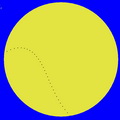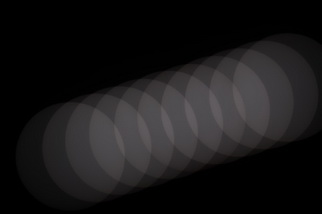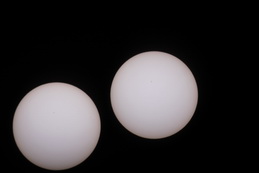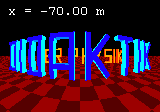
Hannover 2016
horizontal view
Internet Project
Transit of Mercury, May 9th, 2016

Hannover 2016
equatorial view
 Hannover 2016 horizontal view |
Internet ProjectTransit of Mercury, May 9th, 2016 |
 Hannover 2016 equatorial view |
You can find detailed information about photographing of the sun inside of our transit of venus project. On this page we only give short tips in order to motivate the participants doing exercises early before May 9th.
The following picture shows the combination of a test serie which served to find out the optimal time difference. In order to find the orientation of the own images the time difference should be as large enough to seperate both pictures of the sun. Shorter differences are possible as well, but the accuracy will be the better the larger the seperation between the discs is.
 |
|---|
| Serie of images with Δt=30s |
The images have been superimposed with the public domain program ImageJ by using the "average intensity"-option. Other image processing software may be useful as well.
The following photos demonstrate the procedure of "twice exposuring": The photos have been taken with fixed camera on March 8th, between 9 and 10 UT with an exposure time of 1/4000 s. Everybody will have to find out the exposure time which is optimal for his optical system.
 |
||
|---|---|---|
| 09:29:29 UT | 09:32:00 UT | "Twice exposured" image with Δt=151s |
For this combination the "max. intensity" option has been chosen.
On May 8th, the sun showed two little sunspots. By using our little program evaltransitpicts it is easily possible to measure the angular radius rS of the sun and the positions (ρ',θ') of these spots:

|

|
Editor: | Udo Backhaus |
last update: 9.03.2016 |

|